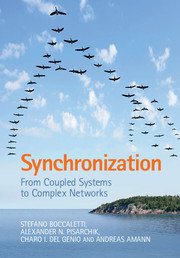5 - Complex Networks
Published online by Cambridge University Press: 22 March 2018
Summary
The final chapter of this book is devoted to the study of the synchronization properties of systems whose structure of connections forms a complex network. The main focus is to show how the structural properties of the networks affect synchronizability. In addition, we discuss how to assess the stability of the synchronous state in networks, including the case of time-varying structures and multilayer networks. Finally, we describe an experimental setup that can help in studying networked systems.
Introduction
In the previous chapters we introduced distributed systems and started discussing their dynamics. So far, we have dealt with a rather simple connection topology: each system was either coupled to every other system, or only to its nearest neighbors in some spatial arrangement. However, such simplifications are not always adequate to model real complex systems.
Over the past two decades, a better paradigm – that of networks – has come to be recognized as central for the study of real-world systems. Network models are routinely applied to a wide range of questions in many research areas (Albert and Barabási 2002; Newman 2003; Boccaletti et al. 2006a, 2014). The representation of a complex system as a network, i.e., a set of discrete nodes connected in pairs by discrete links, called edges, provides a conceptual simplification that often allows researchers to gain deep analytical insights.
Since the links in a network always connect pairs of nodes, it is possible to represent any particular connection topology as a matrix, which takes the name adjacency matrix. In its simplest possible form, an adjacency matrix A is a 0–1 matrix such that Ai, j is 1 if and only if a link exists between node i and node j, and is 0 otherwise.
If no link in a network has a preferential direction, then Ai, j = Aj, i, and A is a symmetric matrix. Conversely, one may attach a directionality to the links, which is useful when modeling systems in which the interaction between two nodes has univocal origin and destination. In this case, the symmetry condition for the adjacency matrix is not necessarily fulfilled. Finally, if not all the interactions have the same intensity, then the elements of the adjacency matrix are not restricted to the domain ﹛0, 1﹜. When this happens, the network is said to be weighted, and its connectivity matrix is often called a weighted adjacency matrix.
- Type
- Chapter
- Information
- SynchronizationFrom Coupled Systems to Complex Networks, pp. 185 - 236Publisher: Cambridge University PressPrint publication year: 2018



